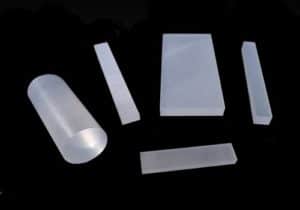

CsI(Na) Scintillation Crystal
Sodium activated cesium iodide (CsI(Na)) is another widely used material nowadays. It’s High light output (85% of NaI(TI)), emission in the blue spectral region (in coincidence with the maximum sensitivity range of the most popular PMT with bialkali photocathodes). Lower hygroscopicity in comparison with NaI(TI) to make this material alternative for NaI(TI) in many standard applications. The temperature dependence of light output can be 80°C max. The decay time of CsI(Na) depends on the dopant concentration, it’s an excellent material in oil logging industry.
Application
1 ) Oil and gas exploration – well logging
2 ) Nuclear physics
3 ) Environmental monitoring
4 ) Industrial – Thickness or density gauging, coal / mineral assy
Features
1 ) High energy resolution
2 ) Emission spectrum well matched with the sensitivity curve of photomultiplier tubes (PMTs) with bialkali photocathodes
3 ) High light output
4 ) High Gamma ray stopping power
Properties
Density (g/cm3) | 4.51 |
Melting point (K) | 894 |
Thermal expansion coefficient (K-1) | 49 x 10-6 |
Cleavage plane | none |
Hardness (Mhos) | 2 |
Hygroscopic | yes |
Wavelength of emission maximum (nm) | 420 |
Lower wavelength cutoff (nm) | 300 |
Refractive index at emission maximum | 1.84 |
Primary decay time (µs) | 0.63 |
Afterglow (after 6ms) (%) | 0.5 – 5.0 |
Light yield (photons/MeV) | 38000-44000 |
Photoelectron yield (% of NaI(Tl)) | 85 |
